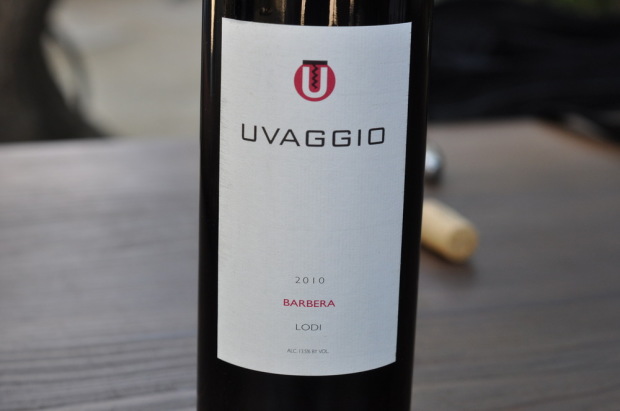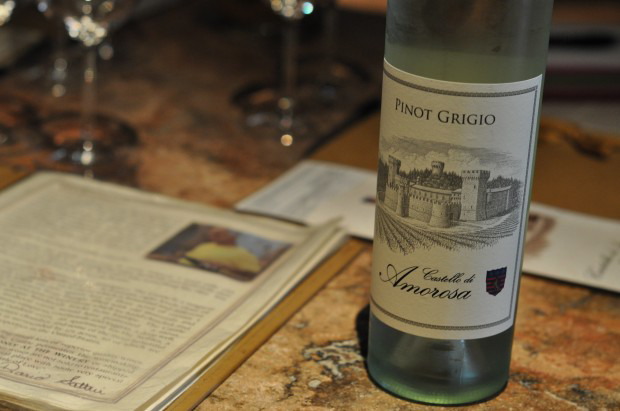Bringing Ribolla Gialla to California

“I had started Luna with John Kongsgaard as the first wine maker, and John said to me, ‘Let’s go to Europe and find the holy grail of Pinot Grigio.’ Our first crush of Pinot Grigio was in 1997. So, we went to Alsace, and loved the wines. But it was not for Napa–not like our soils, or our environment. So, then we went to Alto Adige, in the North of Italy, but there it was too cold. We ended up in Friuli. The area is different, but more akin to Napa. Then our very last appointment before we were leaving we met Stanislao Radikion. It was 7:30 at night and we stayed till after 1:30 in the morning, leaving Italy the next day.
“John and Stanislao hit it off in terms of wine making–whole cluster press, barrel fermentation, natural yeast. So, in 1997 we started going to Friuli. We’d bottle our wine, then bring it to our friends in Friuli. It afforded us expanding our friendships there, and deepening them. We’d share our wine and say, ‘okay, give us our grades.’
“After a few years, we were tasting different wines there and I fell in love with Ribolla Gialla. We were close with Josko Gravner. So, I came back to the states and looked, but then you couldn’t find any Ribolla Gialla. We had planted some Pinot Grigio for Luna here around the house. But it didn’t take. So, in 1999 we put in Ribolla Gialla. Then in 2000 we grafted another acre. So, now we have two and a half acres of Ribolla Gialla.
“I took the Ribolla Gialla back to Luna. But by then it had started getting more mainstream, and I thought this is ridiculous. So I started making Ribolla Gialla myself, and bottled it under my own label–Vare.
“We expanded our friend base from Friuli, and started having friends in Slovenia too. Ribolla Gialla is a very tannic white, one of the most tannic, I believe. It is a fabulous blending grape. It has a lot of body. You can blend it up to 50% with another varietal, and it will retain the flavor of the other varietal while adding the body of Ribolla Gialla. Then the wine has interesting character.
“Here in California now there are eight different wineries that use Ribolla Gialla either as a varietal or blend. On one of our trips to Friuli we were with Gravner and in the corner there was a barrel with a clear side. You could see into the barrel. He brought me over and said it was full of Ribolla Gialla that had been in there on skins for over a year. I thought, this is going to be a god awful mess but it was phenomenal. So, we came back and we made it.
“One year we had too much Ribolla Gialla so we decided to try a dessert wine. We hung it out in the vineyard and it became a moldy mess. It didn’t work. Another year we decided to try a bubbly Ribolla Gialla. Friuli doesn’t make it sparkling. But I asked a friend and he told me in Slovenia they do. There they make it 50% Chardonnay, 50% Ribolla Gialla. So, I spoke with Bobby from Langevin. He makes the best chardonnay in California, in my opinion. He wanted to try sparkling chardonnay but didn’t have the equipment. So I told him I could make it here and traded him for chardonnay. I made it both ways, one all Ribolla Gialla, and one 50/50 with Chardonnay. It is completely dry because it is not disgorged. We had fun with it.
“Now, Aleks Simcic, my mentor in Slovenia. When we first met he told me that the grape requires skin contact. I said, how much? And he said, it depends on the year. Oh, that’s helpful. So, we made eight different lots, each with a different amount of skin contact. One whole cluster. One 24 hours soaking. One 48 hours soaking. Then another we just put the crush right into the press. We tasted all of them, and the 48 hours was our fav. and the crush on the press was almost the same. It seems to work beautifully for skin contact. So, from then on we used the crush on the press. Robbie up in Calistoga though has no crusher. So, he pressed the fruit. The skins were still in the press and he just poured the juice back in. Enrico Bertoz did it that was too for two years. It worked.
“I don’t really sell commercially anymore. I used to particularly in New York City. But I didn’t want to travel it around to sell anymore. So, now I really only sell to the French Laundry. Their Sommelier came over to help with blends one time and he said, ‘George, if you can make these in 500 ml I’ll buy all of it.’ I said, done! That’s how I got into 500 ml.
“I wanted to plant more Ribolla Gialla but vineyard land here hasn’t come down so it’s not economically viable to expand it.
“Somehow Randall Grahm got interested in Ribolla Gialla so he tracked me down and we talked on the phone. Then he came up here and we had lunch. He told me he has a big experimental vineyard spot so I gave him cuttings enough for 10 acres. I figured, Randall is the best marketer of wine anywhere, so wouldn’t it be great if he made a name for it? Then there is always room for a high end version from up here.
“As you know, wine in Friuli is part of every meal. It is the most wonderful food wine I know. Probably partly because of the tannin.
“I personally believe some producers in California are doing really unique things. Now that the bloom is off big overripe California wines, these people are starting to get attention. That is the future of the wine industry, and I love supporting that.”
***
Thank you to George Vare.
Attending Ribolla Gialla University, Part 1: Meeting George Vare: http://wakawakawinereviews.com/2012/07/19/attending-ribolla-gialla-university-part-1-meeting-george-vare/
Attending Ribolla Gialla University, Part 3: http://wakawakawinereviews.com/2012/07/19/attending-ribolla-gialla-university-part-3-friuli-fest-2012-ribolla-gialla-tasting-and-discussion/
Attending Ribolla Gialla University, Part 4: Harvest of the George Vare Vineyard with Steve Matthiasson: http://wakawakawinereviews.com/2012/09/14/attending-ribolla-gialla-university-part-4-harvest-of-the-george-vare-vineyard-with-steve-matthiasson/
Attending Ribolla Gialla University, Part 5: Russian River Valley Ribolla Gialla, The Bowland’s Tanya Vineyard: http://wakawakawinereviews.com/2012/09/29/attending-ribolla-gialla-university-part-5-russian-river-valley-ribolla-gialla/
Attending Ribollat Gialla University, Part 6: The Vare Vineyard Tasting, Arlequin Wine Merchant: http://wakawakawinereviews.com/2013/04/23/attending-ribolla-gialla-university-part-6-the-vare-vineyard-tasting-arlequin-wine-merchant/
Attending Ribolla Gialla University, Part 7: The Matthiasson Vineyard, Napa: http://wakawakawinereviews.com/2013/05/01/attending-ribolla-gialla-university-part-7-the-matthiasson-vineyard-napa/
Copyright 2012 all rights reserved. When sharing or forwarding, please attribute to WakawakaWineReviews.com




























































































































































































